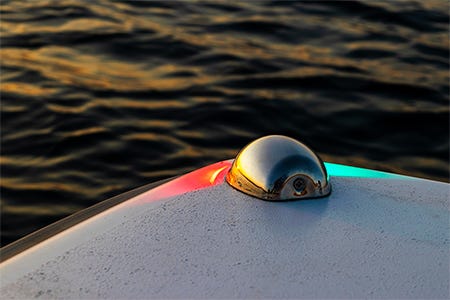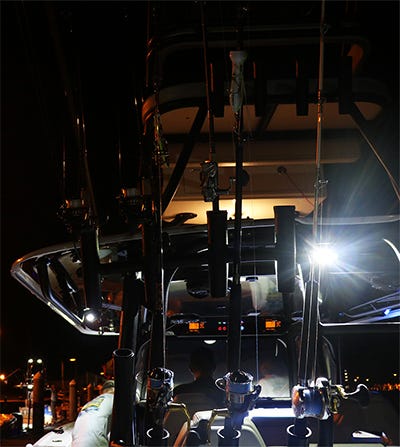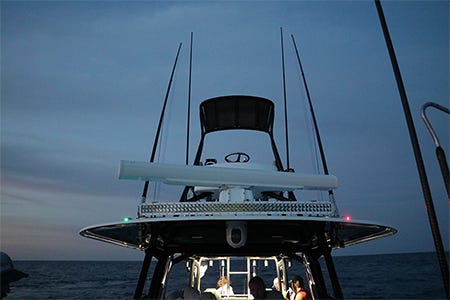

With the advent of powerful, energy-efficient LED lights, many boaters have upgraded their vessels with additional lighting systems to improve both aesthetics and functionality. Accent lights can be mounted discreetly under gunwales, on T-tops and in hatches, providing both visibility and color and making an evening cruise even more enjoyable.
Spreader lights, lightbars and docking lights can be easily mounted to make navigation safer and easier even on the darkest of nights. These lights are relatively inexpensive, easy to install and simple to wire, making them increasingly popular, but there are a few things to know if you are considering adding these to your boat.
Nighttime Navigation Regulations
There are very clear rules for operating a vessel between sunset and sunrise. Part of those rules dictate the lighting that vessels must display based on their size and activity. Having these navigation lights installed and working properly isn’t enough. They also have to be visible from all required angles, and no other lights can be used that might interfere with these required navigation lights.
Additional Lighting
Any additional lighting that can either impair another boater’s ability to interpret the required navigation lights, or that might create confusion in the arrangement, violates USCG navigational rules and can put you and your occupants at risk.
Color Considerations
Keep in mind that navigational lights use very specific colors, combinations and arrangements, all designed to allow other boaters to quickly discern the heading, size and activity of your vessel. This means that “accenting” your boat with any green, red or white light can create confusion for other boaters. Use of these colors should be avoided, or their positioning should be such that they are invisible to other vessels.
Mounting Locations
The positioning of any additional lights on your vessel must be regulated first and foremost by the navigational requirements. This may limit the mounting of additional lights from areas that would otherwise be desirable locations. For example, mounting and operating a forward-facing spreader light or light bar that diminishes the visibility of your less bright red and green colored sidelights can interfere with another boater’s ability to determine your heading.
Using Lights at Night
Depending on your intended use, you may have more flexibility in where and how you add lighting to your boat.
The main thing to keep in mind is that the primary purpose of navigational lights is for other boats to be able to see you and interpret your heading and intent. As long as that requirement is met, additional lighting can be added to help your own navigation, docking, or convenience.
Use Sparingly
While navigational light regulations may limit the constant use of accessory lighting, these rules only apply when you are underway or at anchor.
The same spreader light that would conflict with navigational regulations while underway on the intercoastal waterway would be perfectly appropriate if used only to dock your boat or for short use during navigation.
The primary purpose of navigational lights is for other boats to be able to see you.
Less Is More
Regardless of the rules and regulations that dictate the use, color and location of lighting on your boat, common sense and consideration for others will go a long way to keeping everyone safe on the water at night. It may seem counterintuitive, but when it comes to artificial light at night, less is more.
There is a good reason that navigational lights are relatively low powered, low intensity units. Maintaining night vision is essential for any captain, and even the faint glow of electronics such as GPS and sonar units can limit an operator’s ability to spot unlit channel markers or other obstructions. The less artificial light you have, the more your eyes can adjust to the natural ambient light around you. Artificial light tends to be concentrated to a specific area, reducing your overall visibility and blinding you to the broader area around you.
Sometimes it’s better to go “dark” and go slow than it is to turn on the hi-beams and proceed on plane.
Lightbars
Keeping your own night vision intact is critical, but it is also important to protect the night vision of other boaters in the area. Many boaters forget that the high-powered beam of a spot light or light bar that they are using may blind other boaters from being able to see channel markers or pilings in their path. That bright light may be great for the owner’s visibility, but he will completely blind any captain around him.
If you choose to install a lightbar, use a spotlight or even a flashlight, remember that you may be inadvertently blinding those around you, increasing the risk of collision. Limit the use of these as much as possible, and remember that, once they are used, it will take time for everyone’s eyes to adjust back to the ambient light around them.
The Best of Both Worlds
If you boat after dark, accessory lighting can add a great deal to the aesthetics and functionality of your boat. Subtle, colored and recessed LED strips can create just the right “mood” for an evening cruise. Well-placed courtesy lights can provide the illumination needed to safely move about the boat and avoid tripping hazards.
High-powered light bars and spotlights can help detect potential hazards long before they become a real danger.
But all of these accessory lights have one major drawback. While they brighten the area in which they are directed, they blind you — and other boaters — to potential dangers outside the beam. Thoughtful positioning, limited use and consideration for others can make these lights a true asset to your vessel and limit the negative impacts.



